(BIVN) – Community input is being sought on a handful of conceptual plans for big changes at Hawaiʻi Volcanoes National Park.
The National Park Service and the U.S. Geological Survey are seeking public comment on four initial design concepts for the proposed Hawai‘i Volcanoes National Park Disaster Recovery Project, and they are going to use a virtual civic engagement process due to the COVID-19 pandemic.
From a National Park Service media release:
The intent of the project is to repair and/or replace critical park infrastructure and USGS-operated facilities and equipment damaged during the 2018 eruption and summit collapse of Kīlauea volcano. The project also includes plans for the potential future use of the Uēkahuna Bluff area, a site considered sacred to many Native Hawaiians and other groups.
Beginning in May 2018, the park and Kīlauea summit underwent a major change as magma drained from the chamber beneath Halema‘uma‘u Crater, and the caldera began to collapse, triggering 60,000 strong earthquakes and clouds of rock and ash that continued until early August. The seismic activity was primarily centered near the crater, and significantly impacted buildings in the immediate vicinity on Uēkahuna Bluff, including Jaggar Museum and the USGS-operated Reginald T. Okamura facility and equipment, resulting in the closure of the area. The 2018 eruption and caldera collapse were the most destructive eruptive events in Hawai‘i in the last two centuries.
The results of an initial post-disaster assessment conducted in October 2018 found that significant investment would be necessary to make Jaggar Museum and the USGS Hawaiian Volcano Observatory-operated Reginald T. Okamura building safe to occupy and operational. Most importantly, the buildings are surrounded by fault lines and the area continues to subside on the crater side, undermining slope stability at the existing terraces and building foundations.
In addition, the project presents solutions to overcrowding at Kīlauea Visitor Center (KVC), ranging from renovation to rebuilding the facility elsewhere in the park. The existing KVC building is inadequate for current visitation due to its small size, and the closure of Jaggar Museum has exacerbated the overcrowding of KVC by concentrating all visitor contact in one location.
One of the associated public documents contains various maps showing existing conditions at the national park, as well as the four concepts under consideration, while another document presents an accompanying narrative. Some proposed actions are common to all four concepts, like the following pertaining to Uēkahuna Bluff, where the Jaggar Museum and USGS HVO building are located.
Uēkahuna Bluff
- Due to damage sustained in the 2018 eruption, the historic Jaggar Museum and non-historic Reginald T. Okamura (Okamura) building would be demolished, and most of the existing footprint would be restored to natural conditions. Some remnant elements from the buildings may be salvaged and incorporated into a viewing shelter located on site.
- The Geochemistry Annex (Annex) building would be repaired for interim use by U.S. Geological SurveyHawaiian Volcanoes Observatory (HVO) and National Park Service (NPS) administration until the new USGS field station is completed, at which time the Annex may be demolished.
- The existing restrooms would be repaired for continued visitor use.
- The existing paved and walled overlook in front of the restrooms, Annex and Jaggar Museum would be repaired and improved. Improvements would include enlarging the overlook to incorporate some of the footprint of the Jaggar Museum and adding an open-air viewing shelter.
- A second area, previously used by the public as an informal viewing area, would become a formalized overlook, with possible hard surface and perimeter walls, located along Crater Rim Trail south of the public parking area. The existing Crater Rim Trail would be maintained.
- The existing radio tower and radio room will remain. The existing water tanks may be replaced or removed, depending on if the Annex remains long term. In the future and if needed, add visitor parking capacity by constructing a new parking lot on the other side of Crater Rim Drive. This would alleviate severe congestion and resource damage that occurs during summit eruptions. The Jaggar Museum to Nāmakanipaio Trail connection would be re-routed if this parking is constructed.
Concept 1
Concept Statement:
Create a consolidated interpretive, education and research campus by relocating facilities and functions formerly at Uēkahuna to an area adjacent to existing primary visitor use areas. Construct a new stand-alone visitor center on the south/caldera side of the Crater Rim Drive to enhance pedestrian connectivity to most visitor facilities and caldera views. The current KVC is repurposed as an education center. USGS functions are located adjacent to the visitor use area. Leverage existing parking and utilities with minor realignment and expansion needed to accommodate replacement facilities and visitor use levels.
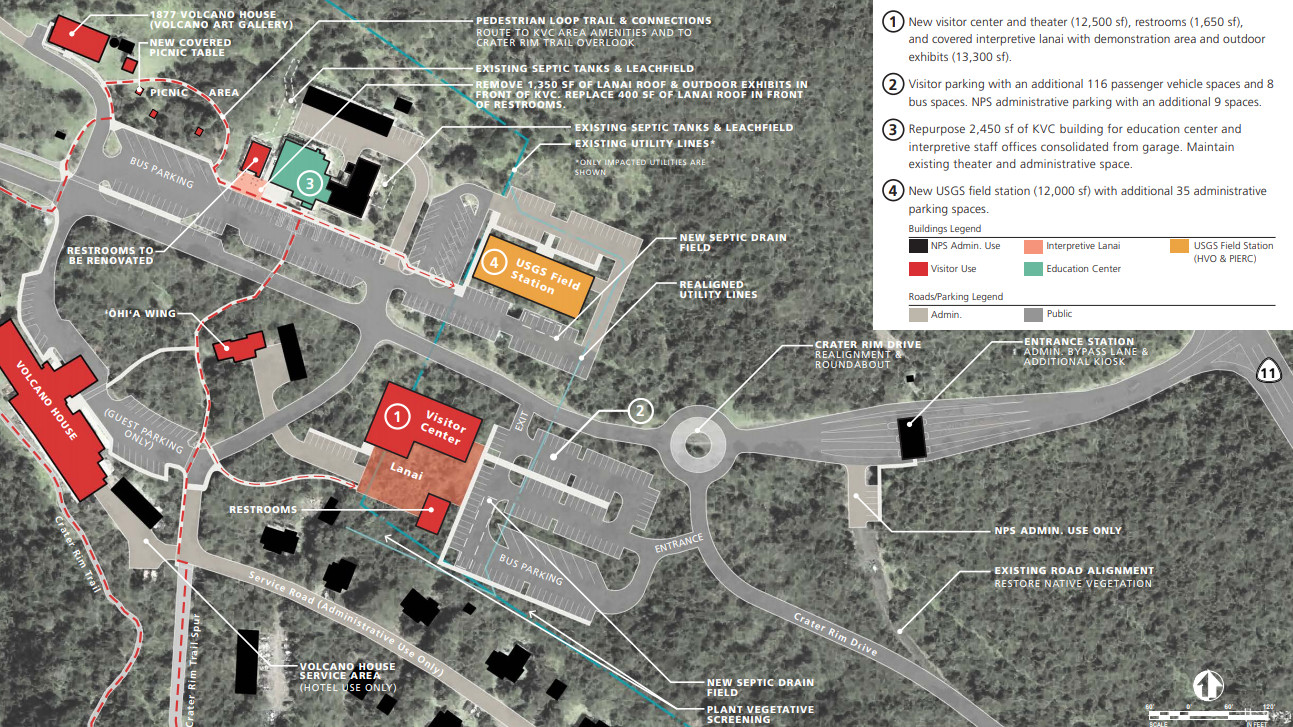
From HVNP Disaster Recovery – Concept Development (May 2020) Concept 1 | Kīlauea Visitor Center (KVC) Area
- A new visitor center with a separate restroom building would be constructed on the south side of Crater Rim Drive near the park entrance in a currently forested area, and includes a covered lanai, outdoor exhibits, theater, visitor parking, bus parking, NPS administrative parking, pedestrian circulation, and a new wastewater system.
- A new visitor center would be large enough to accommodate the visitor functions currently provided at KVC and previously provided by Jaggar Museum.
- A new visitor center would allow a single, easy-to-find stop for the interpretation of the park’s defining features in a coordinated and consolidated manner.
- New covered picnic tables would be constructed in the existing picnic area adjacent to the 1877 Volcano House.
- Visitor use in the KVC building would be relocated to the new visitor center. The existing KVC building would be repurposed as an education center with existing NPS office and auditorium uses being maintained.
- The existing education center in the NPS administrative area would be repurposed for NPS administrative use.
- A new USGS HVO & PIERC-KFS Field Station, parking and wastewater system would be constructed to the east of the KVC building in a section of previously disturbed forest which is fragmented by utility corridors and an unpaved parking lot.
- An administrative bypass lane, additional fee booth and replacement staff parking would be added to the existing entrance station.
- Crater Rim Drive would be realigned and a roundabout would be constructed to improve traffic flow, safety and wayfinding at the Crater Rim Drive intersection.
- Existing water and communications lines would be utilized with minor relocation and connection spurs.
Concept 2
Concept Statement:
Consolidate visitor use adjacent to existing primary visitor area. Construct a new stand-alone visitor center east of the existing one. The existing KVC is repurposed as an education center. Leverage existing parking and utilities with expansion needed to accommodate replacement facilities and visitor use levels. USGS functions are separated from the main visitor use area at the park but are still in close proximity to park emergency operations.
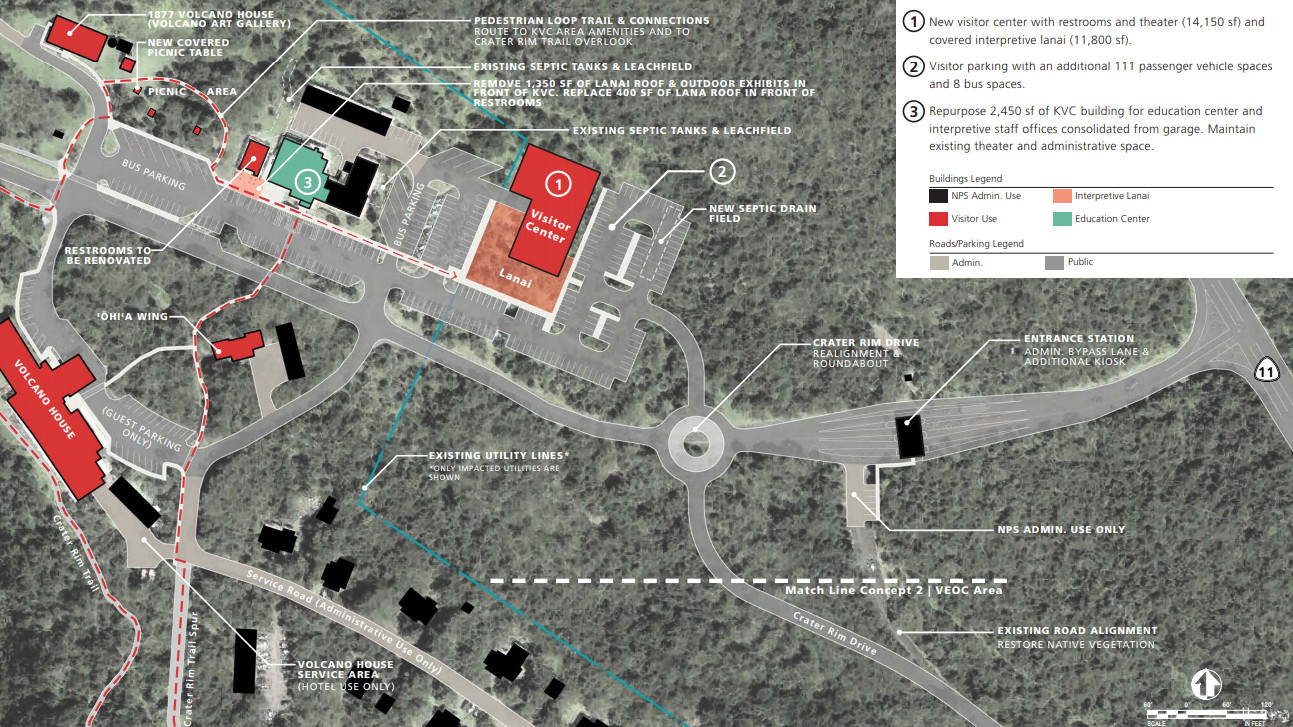
From HVNP Disaster Recovery – Concept Development (May 2020) Concept 2 | Kīlauea Visitor Center (KVC) Area
- A new visitor center with interior restrooms would be constructed east of KVC and includes a covered lanai, outdoor exhibits, theater, visitor parking, bus parking and pedestrian circulation.
- A new visitor center would be large enough to accommodate visitor functions currently provided by KVC and previously provided by Jaggar Museum
- A new visitor center would allow a single, easy-to-find stop for the interpretation of the park’s defining features in a coordinated and consolidated manner.
- New covered picnic tables would be constructed in the existing picnic area adjacent to the 1877 Volcano House.
- Visitor use in the KVC building would be relocated to the new visitor center. The existing KVC building would be repurposed as an education center with existing NPS office and auditorium uses being maintained.
- The existing education center in the NPS administrative area would be repurposed for NPS administrative use.
- A new USGS HVO & PIERC-KFS Field Station, parking and wastewater system would be constructed near the Visitor Emergency Operations Center (VEOC) in a currently forested area.
- An administrative bypass lane, additional fee booth and replacement staff parking would be added to the entrance station.
- Crater Rim Drive would be realigned, and a roundabout would be constructed to improve traffic flow, safety and wayfinding at the Crater Rim Drive intersection.
- Existing water and communications lines would be utilized with minor relocation and connection spurs.
Concept 3
Concept Statement:
Maximize reuse of existing visitor space by repurposing the existing visitor center and auditorium area and constructing an adjacent smaller new visitor center and expanded parking area. Leverage existing parking and utilities with expansion needed to accommodate replacement facilities and visitor use levels. USGS functions are separated from NPS functions and relocated to the former ballfield area, west of the Kilauea Military Camp (KMC) land assignment.
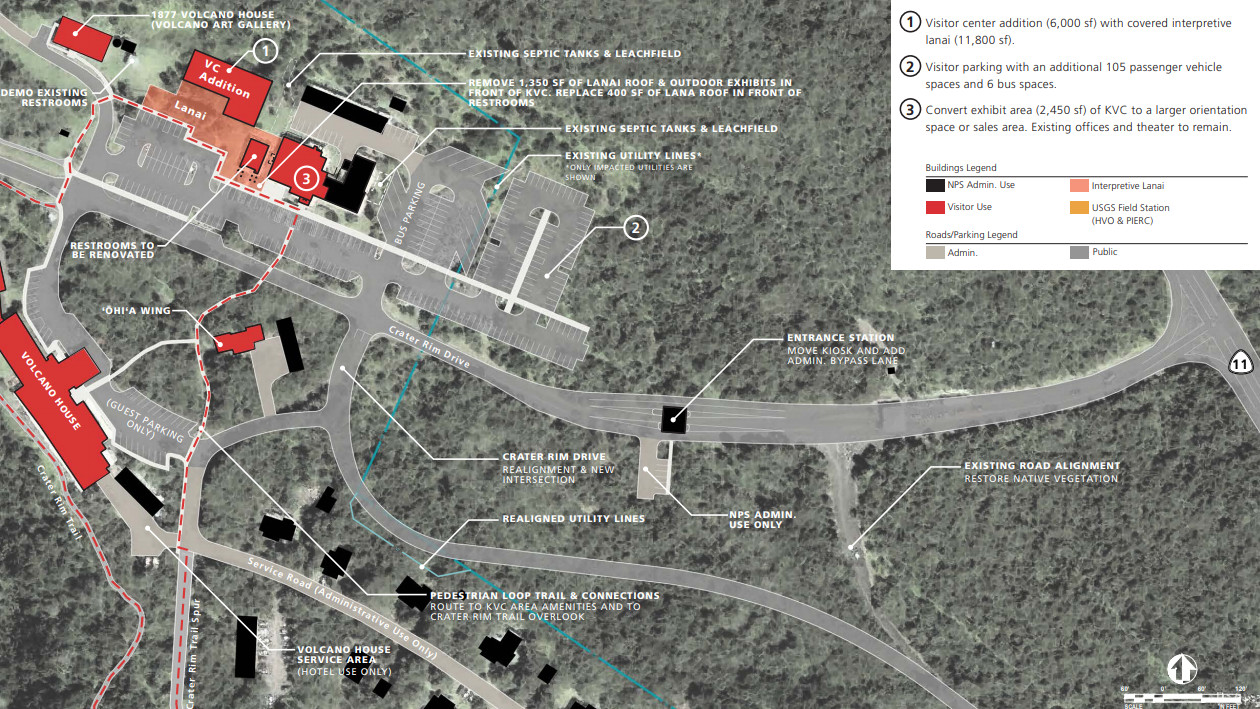
From HVNP Disaster Recovery – Concept Development (May 2020) Concept 3 | Kīlauea Visitor Center (KVC) Area
- A new visitor center addition (separate building) would be constructed on the west side of the KVC in an existing developed landscape and includes a covered lanai and outdoor exhibits along with visitor parking, bus parking and pedestrian circulation. The lanai would connect to visitor parking and the KVC.
- Together, the existing KVC and smaller visitor center addition would accommodate visitor functions currently provided at KVC and previously provided by Jaggar Museum
- The existing KVC lobby would be used for an expanded bookstore and orientation information. Exhibits will be replaced in the new visitor center addition.
- The visitor experience would be segmented into two separate buildings with enhanced wayfinding to guide visitors between areas/buildings.
- A new USGS HVO & PIERC-KFS Field Station and parking would be constructed in the historic former ballfield area, adjacent to the Kilauea Military Camp (KMC) land assignment.
- A new water line, water tank and wastewater system would be constructed adjacent to the new USGS HVO & PIERC-KFS Field Station.
- A new two kiosk entrance station would be constructed to the west of the existing kiosks, which would be demolished. An administrative bypass lane would be added to reduce traffic congestion at the entrance.
- Crater Rim Drive would be realigned to improve vehicular circulation in the KVC area.
Concept 4
Concept Statement:
Relocate the functions lost at Uēkahuna to the former ballfield area adjacent to the KMC land assignment. Visitor services currently provided at KVC and formerly provided at Jaggar Museum are combined in a new visitor center at the former ballfield. A new USGS field station is constructed adjacent and west of the new visitor center. Construct new parking and utility infrastructure to support the new facilities. The existing KVC is repurposed to an education center.
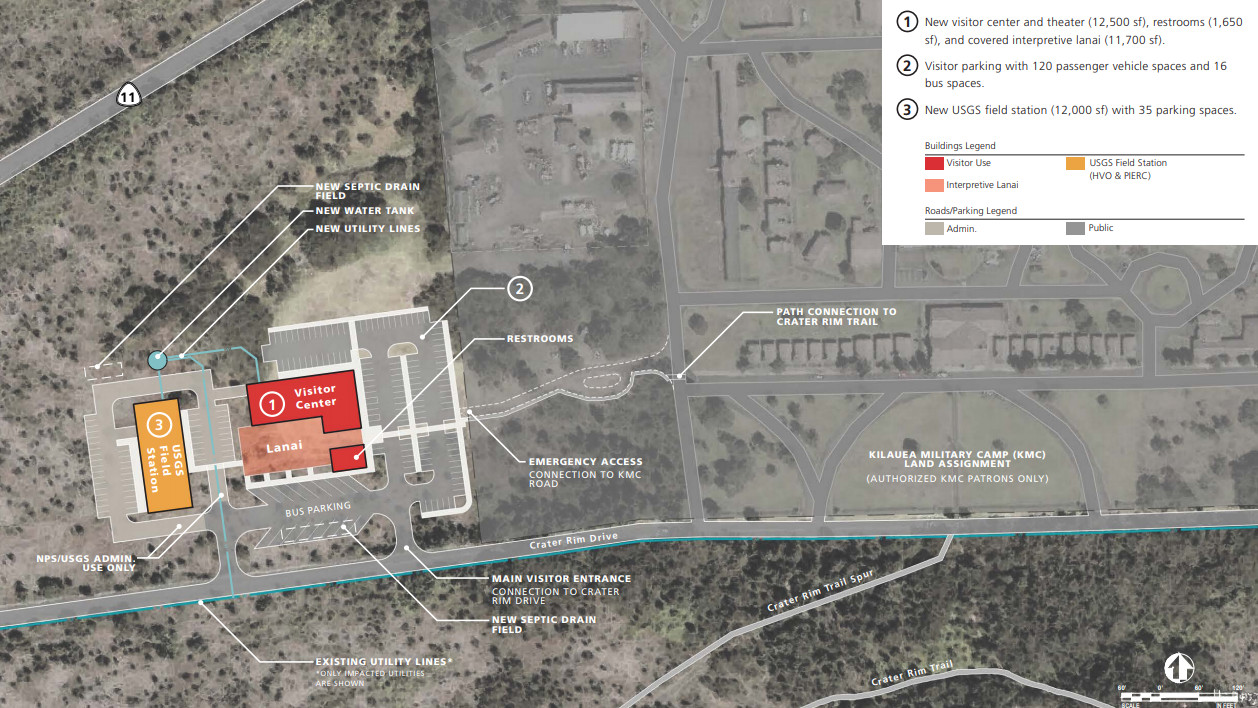
From HVNP Disaster Recovery – Concept Development (May 2020) Concept 4 | NPS Field Area (adjacent to KMC Land Assignment)
- A new visitor center with a separate restroom building would be constructed in the former historic ballfield area, adjacent to the KMC land assignment, and includes a covered lanai, outdoor exhibits, visitor parking, bus parking, NPS administrative parking and pedestrian circulation.
- A new USGS HVO & PIERC-KFS Field Station and parking would be constructed adjacent to the new visitor center.
- A new shared water line, water tank and wastewater systems would be constructed adjacent to the new visitor center and USGS HVO & PIERC-KFS Field Station.
- Visitor use in the KVC building would be relocated to the new visitor center. The existing KVC building would be repurposed as an education center with existing NPS office and auditorium uses being maintained.
- The existing education center in the NPS administrative area would be repurposed for NPS administrative use.
- New covered picnic tables would be constructed in the existing picnic area adjacent to the 1877 Volcano House.
- An administrative bypass lane and additional fee booth would be added to the park entrance station.
- Crater Rim Drive would be realigned to improve vehicular circulation in the KVC area.
To view and comment on the four design concepts and summaries, visit this website.
“Hawai‘i Volcanoes National Park belongs to everyone, and to our future generations,” said Hawai‘i Volcanoes National Park Acting Superintendent Rhonda Loh. “We need to hear from our community and stakeholders about what they envision for their mo‘opuna, their grandchildren, and the generations that will follow.”
“The USGS Hawaiian Volcano Observatory is looking forward to a new field station inside Hawai‘i Volcanoes National Park. A facility in the summit region is vital for our volcano monitoring and research programs that support park management and public safety in Hawai‘i,” said USGS Hawaiian Volcano Observatory Scientist-in-Charge, Tina Neal.
Comments on the HAVO Disaster Recovery Project will be accepted starting May 15, 2020, and the comment period will end June 15, 2020. Following this period, the National Park Service (NPS) will use community feedback received to determine which concept (or modified concept) will be the proposed concept (alternative). At that time, the NPS will evaluate the impacts of the proposed alternative. During this process, if it is safe to do so, the park hopes to hold in-person meetings with the community.
The NPS and USGS encourage civic engagement throughout the process. Public input early in the process is important. The park is currently in the preliminary planning phase of this project, and invites all interested members of the community to voice your ideas, comments, or concerns regarding this effort.

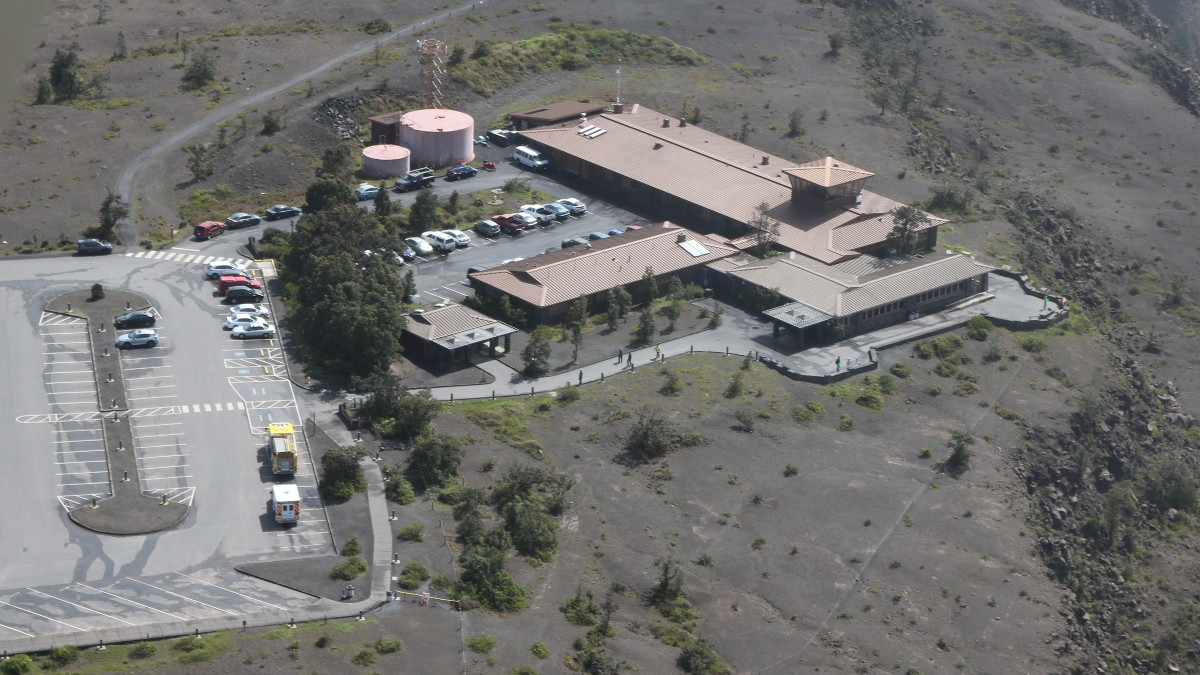
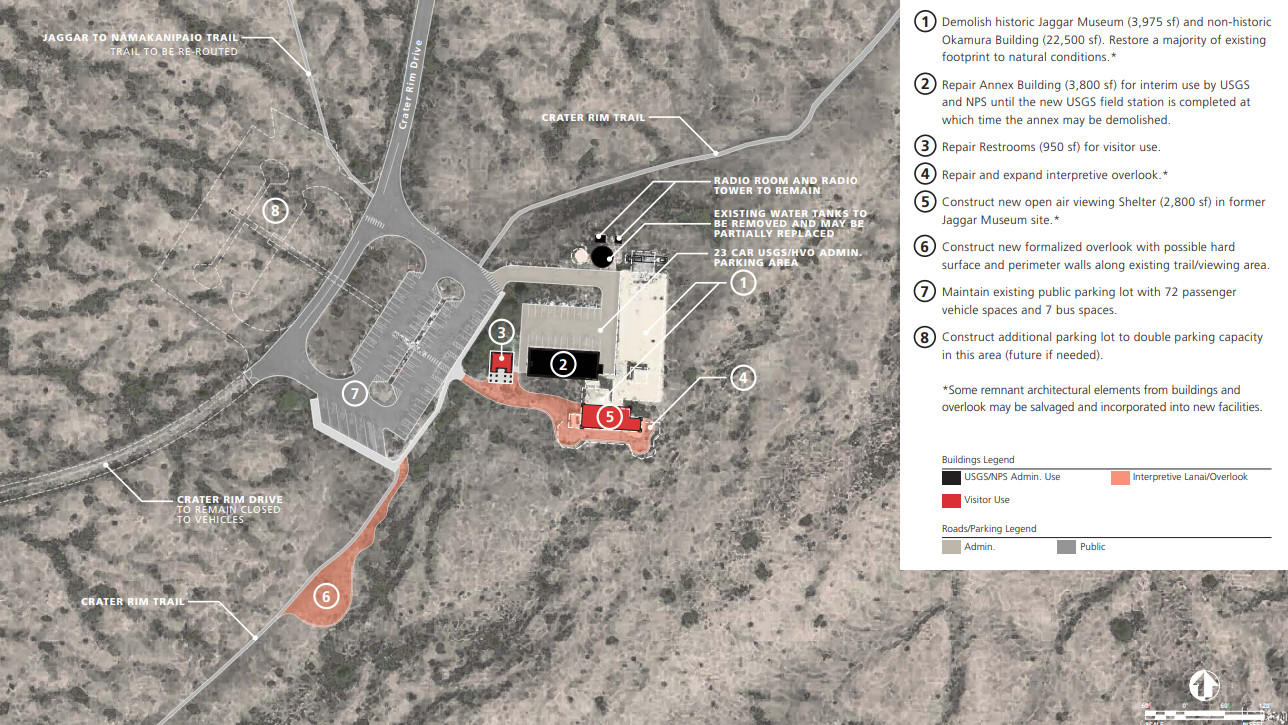

by Big Island Video News9:18 pm
on at
STORY SUMMARY
HAWAIʻI VOLCANOES NATIONAL PARK - Public input is needed to review various concepts in a disaster recovery project following the 2018 Kīlauea eruption and summit collapse.